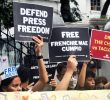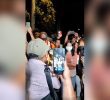Some people might say that the conflict in Mindanao is already “history.” The apparent peace between the Moro revolutionaries and the Philippine government reminds us that it has been years since a violent encounter, whether verbal or in a gunfight, between the opposing sides has been the headline in newspapers.
The road to peace has only been achieved with decisive steps by the Moro people to assert their right to self-determination.
From the early years of Martial Law with Professor Nur “Maas” Misuari of the Moro National Liberation Front (MNLF) to Ustadz Salamat Hashim of the Moro Islamic Liberation Front (MILF), a series of peace talks and armed conflict between the government and Moro revolutionaries have erupted. As heads of the state changed, the Moro people had to deal with and adjust constantly to the situation as well as the elected president’s values and policies.
Currently, the government through peace negotiations granted the Moro people the right to governance through the fledgling government of the Bangsamoro Autonomous Region in Muslim Mindanao (BARMM). This right promises the people moral governance. The vision of their past struggles has finally been realized under the leadership of the MILF.
The MILF has participated in arsenal decommissioning to show its sincerity and willingness to cooperate with the Philippine government in de-escalating further tensions and achieving peace.
The decommissioning of the MILF combatants and their weapons was part of the normalization process agreed upon by the government and the MILF after they signed the peace agreement in 2015.
However, given that the Bangsamoro people already have their right to self-govern, does it mean that the right to self-determination has already been achieved?
This question arises in the light of the following: in the time of the MILF’s upsurge, Ameril Umbra Kato created the Bangsamoro Islamic Freedom Fighters (BIFF). The idea that Moro Revolutionary Fronts were prone to being politically and ideologically divided has always existed. Kato believed that the struggle is for complete independence; that the struggle does not end with the creation of a Moro representative government. This in turn has caused conflict within the group.
The belief in armed struggle as a form of true liberation is more recognized. Some Moros undergo indoctrination in extremist schools of thought; others are dissatisfied with mere assimilation under the national government and prefer to form their own new liberation collectives. Some eventually transform into groups that fight for historical claims of ancestral domain.
The current leadership must not keep these problems unchecked. These might already be signaling the need to restart all the efforts of restoring peace in the Bangsamoro homeland.
And there is the undeniable fact that the Moro revolutionaries are aging, which will probably herald uncertainty.
The MILF leadership, with its firm stand to achieve progress through non-violent means, should remain true to its principles and be able to extend this to the Moro youth who will eventually be its successors. The Moro youth is an essential and decisive factor that can ensure future prosperity.
On the other hand, unpredictable situations might also compel the Moro youth to join the armed struggle.
What is the observable disposition of the Moro community at present?
Some Moro individuals enjoy the same privileges, opportunities, and fair treatment as the average Filipino.
However, this has not always been the case. History has recorded the hostility thrown towards the Moros through the years; their lack of opportunities to live in peace due to constant displacement from armed conflicts, whether in urban spaces or the countryside.
Outright discrimination has always followed the Moro people. They are subjected to terrorist-tagging or profiling, hasty generalizations accusing the radicalizing of the youth through Madrasahs; are commonly portrayed as thugs, bandits, or criminals. They are often mocked for their religion and associated with unpleasant persons of interest.
The Moro people have been historically scarred for life with the Jabidah, Bud Bagsak, Bud Dajo, and Palimbang Massacres, aside from the many encounters and skirmishes that occurred almost daily in Mindanao.
These are some of the reasons why the injustices committed against the Moros have always fueled and justified their armed uprisings.
Are the Moro people and their representatives already healed from these historical injustices?
Although this is not a black-and-white situation where the youth has only two options, the Moro youth still have to study the two lines of historical struggle (peaceful and armed) as they will eventually decide the future — whether it is a future of reconciliation or a future of rectification through armed struggle.
Why are the Moro youth entangled with these two options? Because there is a trifecta among the Moro revolutionaries.
The MILF, MNLF, and BIFF have each pursued different approaches to the right to self-determination. It is up to the Moro youth to decide which to follow.
Regardless of their choice, the Moro youth should recognize that the right to self-determination which their ancestors have fought for is not mere rhetoric. It is the very aspiration for a legitimate people’s genuine liberation that is a birthright to all people, especially the oppressed national minority.
The Moro youth have a choice to assume a progressive and critical position that is actively resisting repression and oppression and ensuring that the citizens can thrive and work in a diverse culture where Muslims, Christians, and Lumads live together as productive members of the region.
The responsibility bestowed upon the Moro youth is not a cup of tea but —
“Su mga pakatundog a Bangsamoro, ngin a ukit e bebpelin nu?”
To the Bangsamoro successors, what path or direction will you choose? (davaotoday.com)
Ansari formerly writes for the Notre Dame University’s Actidamean and the Philwomenian Equivox of the Philippine Women’s College.
Bangsamoro Autonomous Region in Muslim Mindanao, BARMM, Bud Bagsak, Jabidah, milf, Mindanao, mnlf, moro, Moro Islamic Liberation Front, Moro National Liberation Front, Moro youth, Muslim Mindanao, Palimbang Massacres, Right to self-determination




![[ANALYSIS] A different drug war](https://davaotoday.com/wp-content/uploads/2024/09/1000019103-110x100.png)




